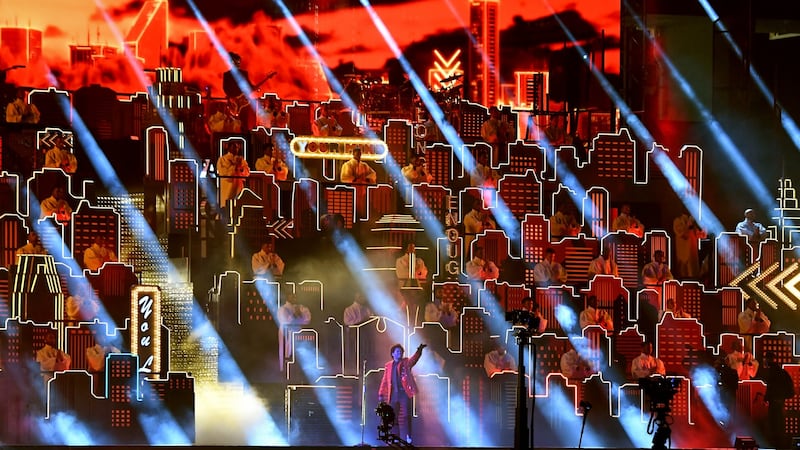I’ve seen it written that the internet killed subcultures. It didn’t; social media, in particular, made it so that subcultures are everywhere and nowhere at the same time. It made them stranger, and more specific than before, but it also brought them into the mainstream.
Online life is full of tribes, fandoms and filter bubbles, groups intersecting and conflicting amid the chaos of the infinite scroll.
Vaporwave might just be the most “internet” subculture of all; lurid, cartoonish, self-referential and wilfully obscure, it’s a near-parodic example of everything you’d expect an online community to be. Vaporwave music relies on synths and samples taken from ’80s and ’90s pop. Muzak, the commercial background music played in shopping malls, features heavily, as do J-pop and power ballads. The genre revives tracks lost in memory, presenting them as distorted, their sentiment worn out with repetition.
I'll admit that a music genre built on neon pink graphics and samples of The Lady in Red probably shouldn't be taken too seriously
Vaporwave art has a similar mood; it’s dominated by neon light, palm trees, synthetic sunsets and the colours pink and blue. Old tech icons and logos, the faces of sad anime girls, and corporate imagery all feature. The mood is one of ecstatic exhaustion; memories compressed like files on a hard drive, history repeating like a glitch on a screen.
The best-known vaporwave album is almost certainly 2011’s Floral Shoppe, by Vektroid. One track, Lisa Frank 420, collected over 40.5 million YouTube views before it was taken down due to copyright claims made by Sony. Its cover image, a Grecian bust of the sun-god Helios, a tiled floor and a picture of a pink sunrise, is so well-known as to work as a visual shorthand for “weird internet”.

Oneohtrix Point Never is another well-known musician with roots in vaporwave. Under the name Chuck Persons, his album Eccojams Vol 1 (there is no Vol 2) is credited with launching the vaporwave genre. Oneohtrix Point Never has collaborated with The Weeknd, whose recent Super Bowl show, with its cyborg choir, neon cityscape and levitating brand names, could be called the most mainstream manifestation of vaporwave yet.
My book, The Disconnect: A Personal Journey Through the Internet, includes a chapter titled Pink Light: Notes on Five Vaporwave Albums. I wanted to write about the genre and the community around it, in part because of what it has given me over the years, and in part because I believe this online art form speaks directly to our times, both before and after the pandemic drove us to spend more time online than ever.
Many readers will have never heard of acts such as Vektroid, Blank Banshee or the fabulously named Death’s Dynamic Shroud. But they’ll likely have seen vaporwave’s influence on our broader culture, in films by the Safdie Brothers, Nicholas Winding Refn and Gaspar Noé, and in video games such as Katana Zero and Hotline Miami. (Failing that, they might have seen vaporwave-lite graphics printed on hoodies sold in Urban Outfitters.)
Fusion
My book explores the intersection between technology and life, weaving together memoir and analysis. In a sense I believe this fusion of the personal and critical is the only way to approach vaporwave, a genre which relies more than anything on feelings, and on evoking nostalgia in its listeners, but which also plays on a deep-rooted ambivalence in its listeners towards the future and the past.
One clue to the genre’s politics lies in the vaporwave “mall tour” videos posted to YouTube; music plays as the camera navigates an empty mall, hovering through food courts, past glassy surfaces and lonely neon signs. It’s likely these videos were originally shot in the late 1980s and early ’90s, the period in which many vaporwave listeners were born. There’s something spectral about these videos; simultaneously, they mock and romanticise the consumer culture of the recent past.

I’ll admit that a music genre built on neon pink graphics and samples of The Lady in Red probably shouldn’t be taken too seriously. But there’s a political argument latent in vaporwave that I genuinely find rich and compelling. The term “hauntology” applies, a portmanteau of “haunting” and “ontology” used by the writers Mark Fisher and Simon Reynolds to describe the past’s haunting of the present. This creates a disconnect all its own; culture becomes a nostalgic prison, one where we experience longing for a future that never came to pass.
To me, this idea also applies to technology; so much of what Silicon Valley sells us as new and “disruptive” is in fact rooted in the ideas and technologies of earlier years.
Despite its often pessimistic worldview, there’s something comforting about vaporwave mixtapes, posted to YouTube and Soundcloud and even, frequently, sold online on old-fashioned cassette tapes. When I first discovered the genre I recognised my own sadness, and my sense of internet-induced exhaustion, in others who had used it to fuel their creativity. We were “alone together”, as Sherry Turkle once wrote. We were lost in the endless scroll, but navigating it together with humour and creative expression.
I felt that same thrill of recognition when I saw the cover of my book for the first time, a vaporwave-inspired design of a classical statue cast in technicolour, its insides glitching and melting. The image captured not only my feelings on vaporwave, but on the internet itself as confounding, intoxicating and occasionally sublime.
My book has been called dark – it is dark, I think, because it would never have been written had I not sunk into a deep depression, accelerated by spending too much time online and not enough in the real world. To come out of it I had to work hard, and write, and make a lot of mistakes (the chapter on internet dating probably demonstrates this, as does the one about my nights of compulsive exercise in a 24-hour super-gym). But I also wanted to capture that dark humour, that strange mix of defiance and vulnerability shared by a generation cursed and privileged to live on the internet.
My story is perhaps a cautionary one, but I’m certain it’s far from unusual. I suspect that most of us spend a little more time online than we’re actually comfortable with. So many websites and apps are, after all, designed to be addictive, making it easier for the people who made them to capture our data. There’s a contradiction at the heart of our internet use, which stops it from feeling satisfying; however many people we connect with, we always scroll alone.
Vaporwave captures this loneliness, but also, by its very existence, it makes me feel less alone. That this genre and its aesthetic would emerge from forums and Soundcloud accounts, and gain enough popularity to endure to this day, gives me hope that some elements of the old web (the weird web, the one where no one used their real name) remain alive, and available as a creative outlet, without taking on the toxic connotations of a place like 4chan.
There’s something apocalyptic about vaporwave; it’s the sound of context collapsing, a beautiful clash. But it hasn’t ended; new tracks and art appear online daily, and the community continues to share their work and support each other. As I write this, I have a vaporwave mix playing in the background, keeping me company as the clock turns to 3am.
When I think of the internet, I picture myself falling down a cybernetic rabbit hole. Images flash on the walls around me, an infinite timeline populated with other people’s lives. Falling faster and faster, I see news stories and fictions, horror and human tenderness.
Vaporwave is the sound of that same synthetic underworld, the one we scroll through alone at night. Eerie and dazzling, it is the sound of the internet itself.
The Disconnect: A Personal Journey Through the Internet by Roisin Kiberd is published by Serpent’s Tail












